After being awarded the $100,000 TED Prize, Paris street artist JR has finally revealed his wish/project to change the world. In this presentation he goes through a retrospective of his phenomenal work and at the very end announces his global art project. 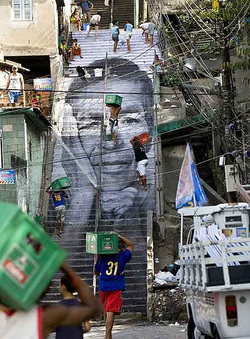 Favela Photo JR himself is skeptical about art's ability to save the world, but his assertion that art provides a neutral ground for discussion is worth considering. It is the conversation that art provokes that has the power to alter perceptions and change consciousness. The art itself is merely a vehicle to create these interactions and share individual stories. So comes the Inside Out Project. In order to spread the untold stories of diverse individuals, JR asks that people all over the world upload black and white portraits to the website. He'll in turn mail you an oversized print of the image for you to post up in your own community. He's arming a global network of street art guerrillas. Since the project's launch on March 4th, 735 images have been uploaded and 150 posters posted. I'm assuming JR requests that people document the postings and send them back while his team will probably also attempt to visit many of these wall exhibitions. Other ways to get involved include donating money or donating wall space. And JR stays true to his graffiti and street art roots by declining any sort of corporate sponsorship or money. (TED money is unconditional) That way he is only beholden to himself and the subjects of the art. Here's to creating a worldwide sidewalk gallery ("expo dureau"?). Let us know if you participate in Inside Out. I may also try to upload a portrait and see what happens. Bonus points to JR for rocking a jacket version of his favela wall postings. The Elvis Costello hat and glasses were also a nice touch to maintain his pseudo-anonymity.
 If race is as much of a competition as its name implies, then it follows that the outcome will result in a hierarchy of winners and losers. Gold, silver, bronze; first, second, third…and sometimes dead last. If race is a construct constructed like the world of track and field, then different countries have their own meets and varied rules. So then what is the race like in France? While kicking it with my boy Babacar, the son of Senegalese immigrants, we compared notes on our respective countries. Unlike many other French who cite differences in cultures as cause for conflict, he outright said there's plenty of racism to go around. Finally some honesty. But are black, brown, and yellow subjected to the same prejudice? Of course not. Babacar broke it down for me. Arabs are treated the worst and are then followed by Black Africans and Caribbeans. He pointed me to a recent study showing that Paris police stop young Arab men 7.5 times more than whites. And by stop I mean pulled aside, ID cards checked, and their bodies searched, all without a warrant and based purely on suspicion. No 4th Ammendment Rights here. Now I know where Arizona got its inspiration.
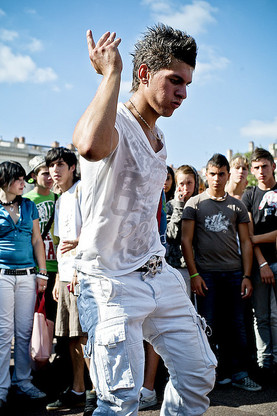 Tecktonik style Blacks too were targeted by the police and stopped 6 times more than whites. Attire contributed to the profiling as 47% of those stopped wore "youth clothing," styles associated with hip hop, goth, and tecktonic. Such a finding only confirms that racial profiling is persistent since hip hop and tecktonic are associated with the youth cultures of the black-brown banlieues. Perhaps goth is as well? Babacar, who rocks a warm smile and equally warm baggy sweats, has himself been searched by the police once or twice coming home from late night parties. "Night police are terrible!" They're the most aggressive, the most rude, the most unrelenting. They're just out to get you. He suggested that the perception of Islam may contribute to the relative status of Arab people in France. It's a nasty mix of improbable assimilation, racial difference (though this multi-culti American doesn't notice too much difference), and heavy immigration that stirs the distaste of the white mainstream.
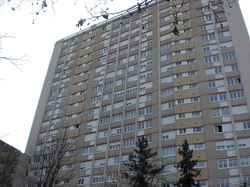 HLM in the 19th Arrondissement What about France's abundant population of Cambodian and Vietnamese refugees, Chinese immigrants, and Tamil-speaking Indians? Like in the US, they lie somewhere between black and white. Stereotypes of obedience and hard work have found root on both sides of the Atlantic. However, Babacar notes that some of the community does live in cites (HLMs), French housing projects, where the hood impact is noticeable. "France is just like the US, except instead of Latinos, we have Arabs." But I raised Babacar's eyebrows when I told him that Latinos enjoy slightly better treatment, that Blacks are still criminalized much more. "Really?" Yes, really. A history of slavery is our stain that may never go away. But at the very least, we talk about it, albeit only sometimes. Race matters.
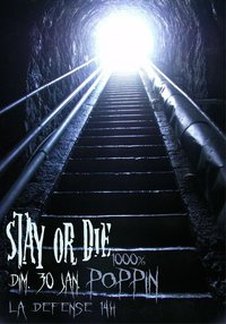 P. Diddy once told me to either Vote or DIE! So naturally I voted. 50 Cent lives by the mantra "get rich or die trying." Those Vitamin Water ads suggest which way his scale is tipping. And here in Paris, our good friend-of-the-blog and celebrated Vertifight organizer Youval has commanded that I "Stay or Die!" While the act of staying seems rather mundane and disproportionate to the severity of death, I must admit that it was an arduous task. I failed to stay, so I died… ….on the dance floor. Last week, once again Youval commandeered the closed shopping space beneath La Defense (Paris' financial district) for a literally underground street dance competition. This time the contest categories were in Popping, House, and All Styles. This time "Stay or Die" was the format. And this time, for the first time in Paris, I competed. I showed up nervous, anxious, and eager to prove myself. There again stood an intimidating mass of 100 young hip hop heads, forming a circle around a portable amp hooked up to an mp3 player. Surrounding them were closed clothes stores, some with signs that read "Skateboarders and dancers, please don't touch the windows." I was among the first group of 6 people called into the circle. My beating heart almost burst out of my chest... I thought we would do a round of preliminary selections in which each person had 30 seconds to get busy, and the judges would select one from the group to advance into the main competition. But then something crazy happened. Youval called out 6 more poppers to the floor. The second group of 6 stood before me at the other side of the circle. "I don't understand," I complained to my friend Mohamed. "What do I do?" "You battle."
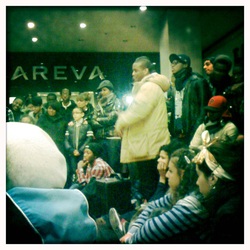 Judge Franquey looks on in his fat North Face. So it was an improvised crew battle, I thought. Each crew sent out one dancer at a time for their moment in the cypher. But unexpectedly, after every other solo, the judges pointed to a side, picking a winner. Even though I don't speak the language, the people there could still read on my face: "HUH??"
One by one, members of the opposing crew sat down, having lost to those on my side. I was the fourth person to go, suddenly aware that this was survival of the fittest. My opponent was alright but not incredible. I smelled blood, hungry for a kill as the adrenaline thrust me into the cypher. I started unloading my arsenal, showing technique, character, hunger. And they cheered. It's all I could've asked for-- respect from the melange of African, Arab, and Asian faces surrounding me. I don't speak French, but I proved to them that I speak dance.
Pretty soon though, overwhelmed by the unexpected cheers, the adrenaline, the pressure, I got lost in that cypher. My mind went blank. The longer I was out there, the more I froze and the quieter the crowd got. I rushed out of the cypher, and looked to the judges. Two pointed to me, one pointed to my opponent. Phew, I got to stay.
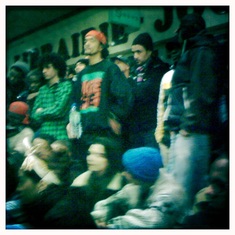 The hyped audience. A few more mp3's into the battle and only one man stood on the other side of the cypher while five on my side remained. He paced brazenly back and forth, staring each of us down like the warrior he was. His name was Amour, the French word for "love." One by one, my crewmates stepped into the circle with Amour. One by one they fell. It was like marching up to the guillotine (French historical reference!). Suddenly it was my turn. I knew resistance was futile, but with nothing to lose, I felt liberated. I danced hard and I had fun with it. I laughed during my own solo. The crowd sensed my liberation and enjoyment, and they cheered. But they cheered even more for Amour. So I died, and he stayed, the last man standing in the circle. Love really does conquer all. Afterwards, friends and strangers alike high-fived me to commend and appreciate. After months in Paris, documenting the lives of others, I finally expressed myself to them. In turn, I felt connected, intertwined into the fabric of their local culture. I'm finally a part of something. I think I'll stay a while.
Here's an example of a past "Stay or Die" battle hosted by Youval. The last person standing from each battle ultimately goes on to face the other survivors.
 I know you're thirsting for more indispensable insights on urban culture on the streets of Paris, but I'm afraid you'll have to wait. Your faithful blogger is currently in India until mid-January. So unless I somehow run into JR putting up posters of Tamil youth on the sides of shanty's, no entries on Paris for a few weeks. However, you can get your blog fix and track my travels at: http://aupindia.wordpress.com. Peace!
Why go to the Louvre to see art when all you have to do is walk around Paris and look up? With a vibrant street art scene decorating the walls, the city becomes a gallery in itself. Allow me to take you on a tour of a few of Paris' most eye-popping areas. MontmartreLet's start with Montmartre, the bohemian sanctuary that served as home and inspiration for many renowned artists like Picasso, Renoir, and Van Gogh. So it comes as no surprise that this neighborhood is overflowing with illegal creativity. It also has one of the highest concentration of pieces by iconic Paris street artist Space Invader. While other tourists stop to stare at the Sacre Coeur, position your eyes on the walls around it. You'll start to uncover an abundance of hidden treasures peaking out from corners and above street signs. The 13th...meaning the 13th arrondissement, home of the artist tenement/incubator Les Frigos. Start there and in its immediate vicinity, you'll notice art spreading out to the surrounding streets. From there, head towards Place d'Italie, the commercial center of the district. Along the way, you're sure to spot the massive orange mural by Polish street artist M-City jutting out of the Paris gray. M-City recently had an indoor exhibition nearby, but couldn't keep his paints away from the walls outside. Once you arrive at the shopping mall at Place d'Italie, traverse along the narrow back streets in the area and you'll spot a bevy of wheatpastes and stencils including a slew of cutesy cutouts by Paris' THTF (The Hand That Feeds). The Moving GalleryThe third and last stop in this installment of Paris' Street Art Gallery is one that you'll only see if it does stop. It's everywhere and yet nowhere in specific. That's because the graffiti in this case adorns the walls of moving vans. Just as it's become popular in New York to cover moving vans with fully developed graff pieces (since the drivers don't really mind), so too have vans throughout Paris begun to carry more than simply furniture. First trains, now trucks, I hope someday soon airplanes will be next. So keep your eyes peeled and make sure art doesn't pass you by.
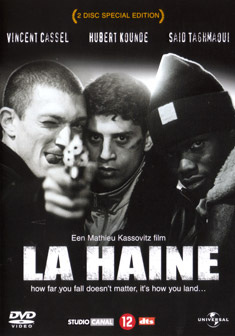 In the third installment of our podcast series with guest Josquin, we talk about the seminal French film La Haine by Mathieu Kassovitz and the incredible French hip hop soundtrack it spawned. The album features a who's who list of French rap acts from the golden era that was the mid 90s: MC Solaar, IAM, Assassin, CutKiller, Raggasonic, and more. The film together with the soundtrack paints a complete picture of the (sub)urban culture of that era. As Josquin points out, it's the ghettoization of the young people's environment that not only gives birth to this true-to-life tale but also gives rise to the emergence of a raw, politically charged French hip hop scene. Together with the albums of NTM and IAM, the soundtrack to La Haine constitutes the canon of most essential French rap records. The trailer below gives a taste of the intensity prevalent at the time, laying the foundation for the riots and discontent of recent years.
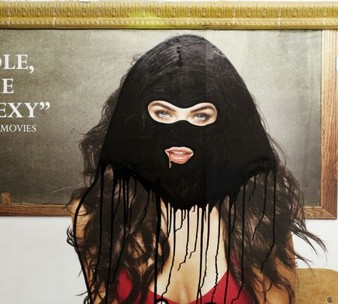 Princess Hijab was here. Just after dawn, when the Paris metro starts running, beware! A looming, long-haired figure skulks around train stations hunting prey. Her targets: consumer advertising. Her weapon of choice: a fat black paint marker. Her method: Hijabisation. Paris' latest street art sensation Princess Hijab stalks the scantily clad women and men on the posters adorning subway platforms and gives them a costume change. In quick, broad strokes, she covers them with a niqab, dripping in wet, black ink. From Dolce & Gabbana to H&M, she leaves a veil trail of topical ad-busting. With the hijab prohibited in schools and the burqa and niqab to be banned from public spaces starting in 2011, Princess Hijab's guerilla art seems like a strike of retaliation. Yet she claims in a recent exclusive interview with The Guardian that she has no judgement on the way people dress, one way or another. She doesn't use the veil as a tool to promote Western feminism or religious freedom. Instead, she uses "veiled women as a challenge." She sees herself as part of a new "graffiti of minorities" that is reclaiming the streets and bringing " inside [Paris] everything that's been excreted out." The niqabs she leaves behind then become a representation for the Paris outsiders who lack opportunities--"the poor, the Arabs, black and of course, the Roma."
The jarring juxtaposition of dripping black veils on the sculpted bodies of massive ads forces people to confront France's larger problems of integration and increasing consumerism. Who Princess Hijab is remains a complete mystery. She reveals nothing about her identity, her religious or ethnic background. Even her sex and gender are unclear and deliberately ambiguous. To her (or him), Princess Hijab is a character. And judging by her costume choice (I'm hauntingly reminded of the girl from The Ring) in this short documentary, her street art is also performance art. Probably a necessity, not just an aesthetic choice, since her pieces get torn down an average of 45 minutes after they're completed. So like Bansky and JR before her, Princess Hijab's true identity remains shrouded in secrecy as her anonymity adds to her cultural appeal. Like Bansky, she subverts mass consumerism with her clever art. Like JR, she gives attention to the marginalized and shares a concern for the disadvantaged communities of the banlieues. But unlike these two predecessors, she imbues her work with a punch-in-the-gut urgency that the others seem to lack, a kind of hardcore fuck-you attitude. It's the gangsta rap to their backpacker rap. Perhaps it's because the veil is such a powerful icon, especially in a Western, Christian space. Or maybe it's the dripping black ink that does it. Either way, Princess Hijab has got your attention. Interestingly enough, Al Jazeera scooped The Guardian months earlier with this video:
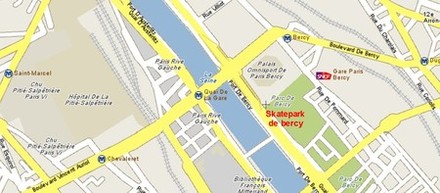 In France it seems that there's no question whether skating is hip hop. B-boy competitions mix with BMX contests, Nas rhymes while Saint Denis youth grind. Paris' skatepark at Bercy is just another iteration of this intertwining culture. Here the energy of young skaters is matched by raw Paris graffiti blanketing every available surface. A skater's explosive aerial tricks compete for your attention with a graff writer's eye-popping aerosol colors. Lying at the edge of Bercy's tranquil park and in the shadow of its Palais Omnisports, the skatepark is easy to overlook. But once there, you become completely enmeshed in the grittiness of street culture. It's impossible to focus your senses anywhere else. Graffeur Jen, whom I met at Les Frigos, first told me about the skatepark, telling me it's another major place for writers to get up. On the cold, dank afternoon I visited, I ran into PESCA who was in the middle of going over someone else's tag on the main wall. Apparently, on these walls, there's no police intervention or fear of repercussion from rival writers.
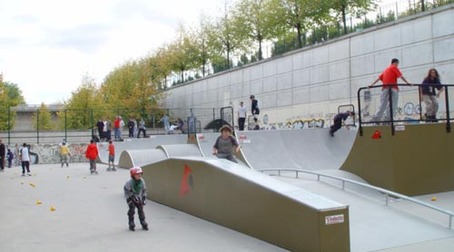 Bercy Skatepark in the early days, before it was graffitified It's only when you go over someone on the illegal walls that you may run into problems. It's like honor among vandals, rules that govern illegal activity. At the park, it's all fair game. Behind him, 8 or more skaters and skateboarders casually hit the ramps, taking smoke breaks in between tricks, chatting it up with their friends or their dog. It felt more like a chill session than a training one. They were young, mostly high school age, and the park was their hang out spot. Ironically, Bercy is the site of the oldest known human occupation in Paris, dating back to 4000 BC. In recent decades Paris has revitalized the area, transforming it into a commercial center and the home of the Ministry of Economy, Finance, and Industry. Yet nestled at its corner is this haven from any of that, a detached shelter for the city's expressive youth. But perhaps that's the point, to draw the skaters and graff writers here and away from the public, keeping them off the city's beloved architecture. Rather than police them, enable them. It's history is unclear to me, but I do know the park has been around since at least 2006. It was also temporarily closed in 2007 as they constructed a roof for it, providing a vital place for youth even during the crappiest of weather (much like this week's when I visited). So there I sat with PESCA at the top of a skate ramp. He told me how Paris writers stick to bubble and block letters mostly, some 3D, but rarely wild style. I asked if he's ever been to New York, and he expressed that he wants to but like other writers here, he spends too much money smoking. During the conversation, one of the inline skaters sped up the ramp. When he reached the summit, he launched into the air like a rocket and somersaulted over our heads. Unphased, PESCA carried on as if nothing happened while I was still sweating for my life. Here, the graff writers are used to the skaters. To them it's all the same.
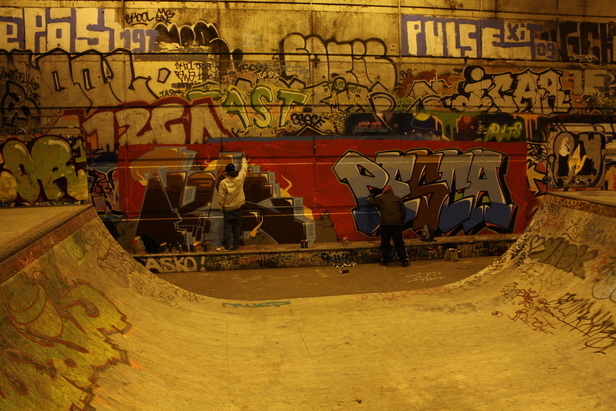 PESCA and TULE get up
 It was the year 2000. Scattered among tapes in my friend's basement in New Jersey, one VHS caught my eye like a diamond in the rough. On the cover graffiti block letters hovered over an ill drawing of a b-boy doing headspins. It was Battle of the Year 1998, and it felt like finding buried treasure in your own backyard: pure gold and straight underground. I had never seen breakin like this before. The basement party cyphers and subway station performances did not prepare me for BOTY, the world championships for b-boy supremacy. Live on stage in Offenbach, Germany, France's The Family faced California's Rock Force Crew in the heated controversial final, Japan's Spartanic Rockers taking "Best Show" honors. Not only an introduction to a culture, it was a gateway to a whole new world. A decade later, BOTY continues to be the biggest and most legendary b-boy event. It's kept the Bronx dance style alive and evolving, providing inspiration for aspiring b-boys in every corner of the world. It's also the focus of Benson Lee's 2007 documentary Planet B-Boy (whose image I sampled for this blog's banner) and is the inspiration for his upcoming feature.
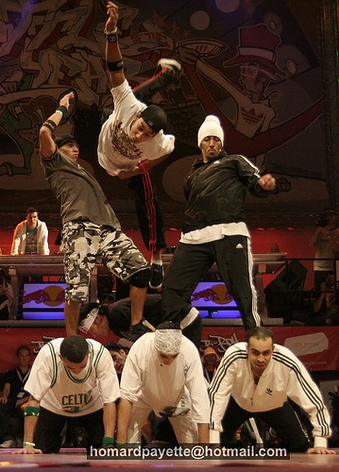 The last BOTY France won was 2006 when Vagabonds placed 1st Celebrating its 21st anniversary this past weekend, BOTY abandoned its home country of Germany for the first time and relocated to Montpellier, France. This changing of the guard marks a major turning point for France's b-boy scene. It's an acknowledgement of France's stature as breakin powerhouse, a country that's produced BOTY champions four times, 2nd place finishers twice, and "Best Show" winners twice. The only country more dominant is Korea, having won six times in the past decade. The event has helped launched the careers of France's best dancers, earning them worldwide renown. "It [BOTY] gave me a name in the world of b-boying," says By of Fantastik Armada, 2004 runner-ups. France's best known street dancer Salah, winner of the first season of Incroyable Talent (France's version of America's Got Talent), made his international debut in the 1998 BOTY final against Rock Force. BOTY started out in Hanover, Germany in 1990 with just over 500 spectators and representation from Germany, the UK, and Switzerland. This past Saturday, the annual event hosted 14,000 in Montpellier's ARENA with crews from 19 countries worldwide (having won regional or national qualifiers), from Israel to South Africa to Brasil, competing for the title. Korea notched another victory in their championship belt as Jinjo crew overwhelmed Japan's Mortal Combat. France's La Smala finished a respectable fourth, but certainly disappointing for the hometown crowd.
Major French TV network Canal covered the event live over the internet, complete with pro-sports-like commentary and interviews. The move to France has certainly increased the event's live audience but new problems have emerged. The MCs now have the cumbersome task of hyping the crowd in English and in French. While English was no problem in Germany, it's obvious that the crowd in Montpellier has a lower threshold for it. And already there's backlash from the b-boy community at the different atmosphere in France's BOTY. On the global forum bboyworld.com, one commenter advocates for a return to the past: "It was the worst crowd in the history of BOTY, bring it back to Germany next year." Others described this BOTY as the "weakest" and "horrible," while another clamored for majority English MCing. BOTY is slated for at least one more year in Montpellier. For the French b-boy scene, it's still a relished honor to host, to attend, and to compete. "Ever since I was a kid," Lilou, of 2003 champions Pockemon, explains, "I dreamt of being on that stage." Next year, France will have one more opportunity to own that stage. Here's a great short documentary on the 10th anniversary of BOTY's qualifications and what it's meant for the local scene:
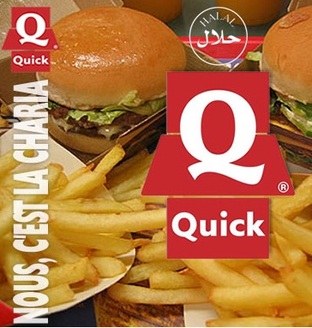 If you only hung out with hip hop heads in Paris, you would start to think that all French people share their food with the people around them. A bite for me, a bite for you, a bite for him, a bite for her. By the time it got back to you there'd only be a nickel-sized piece left. Luckily I've gotten over my inner-germaphobe and paranoia about contracting mono, having shared every can of soda, every piece of candy, and every buttery pastry offered me since I arrived. I've grown so accustomed to it that I've started to initiate the food cypher myself. As they say, "when in Paris…" So when I turned and offered a tasting of my Royale with Cheese to Sou, she shocked me with her refusal. "I can't eat it," she said. Judging by the half-eaten Filet O' Fish in front of her, I ruled out the possibility of her being veggie-tarian. "Waitaminute," furrowing my brow for dramatic effect, "are you Muslim??" (MickeyD's has yet to adopt a halal menu though French rival Quick has.)
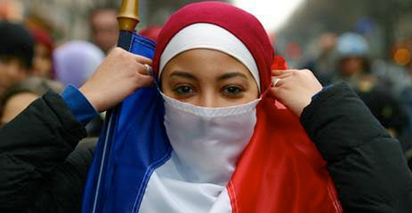 SOU
Sou and I have been friends for over a year and a half. She lived in New York City as an au pair for 6 months. We hung out countless times and not once did her religious faith ever come up. She revealed to me then that while in the states, she deliberately kept it secret; she worshipped Allah on the low. But why? Especially among friends?
Out of fear. "They don't like Muslims over there." Even though I doubt anyone would guess that this young Thai-Cambodian girl with the French accent was Muslim, she still felt the need to suppress her identity for self-protection. The US has produced so much fear of Muslims that it's spawned fear of Americans.
YOUSEF
Weeks later, I met Yousef who expressed to me his desire to one day visit New York. I encouraged him to. But in his broken English, he said that it's a bad idea because once he lands at JFK then…He brought his wrists behind his back to explain the word his vocabulary lacked--detained. He then pointed at his Arabic features, cited his name, and lamented, "It's not possible."
 ISLAMOPHOBIABut I thought it was France that leads the world in Islamophobia, at least against those within its own borders. It's France that bans burqas in public and denies citizenship to those who wear them as well as their husbands. It's France that wants to prohibit fast-food menus from conforming to halal restrictions under the guise of laicite or secularism. It's France that wants to revoke the citizenship of foreign-born French caught assaulting public servants. It's President Sarkozy who referred to the immigrant youth as racaille--a derogatory term meaning low-life scum--that he wants to be rid of. Message transmitted: You don't fit in here so go away.
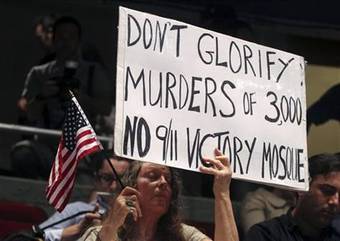 I suppose that's not quite at the level of no-fly lists, secret detentions, renditions, and waterboarding, but still, do people not regard the US as a place of religious freedom and melting pots and a president with Hussein in his name? I was even part of the fight that brought 49 of 51 New York City Council Members to vote for a resolution to adopt the major Muslim holidays as public school system-wide holidays (though the not so tolerant Mayor won't enact it). Then again, millions more know about the fight against the Muslim community center near Ground Zero.
The comparison is pointless. It's like a race to the bottom, finding the worst of two evils. A Muslim cabbie has his throat slashed in New York. A Muslim woman gets attacked while shopping in Paris. Intolerance and inequality know no boundaries. Yet, through shared adversity, strength and solidarity shine through the bigotry. In working class neighborhoods of New York, a certain degree of acrimony simmers amongst African Americans and Arabic immigrants that run local corner stores. Meanwhile in working class banlieues surrounding Paris, African and Arabic immigrants connect through a common religion, parallel cultures, and shared living conditions. Their youth blend into world champion dance crews, mighty rap groups, and all-star graffiti collectives. They find solace in each other as there's always strength in numbers. Afterall, France does have the largest Muslim population in Europe at 10% and totaling over 4.1 million. MOHAMEDMy friend Mohamed, a Moroccan-French beatmaker, learned that I'm of Filipino descent. His immediate follow up question, as his eyes widened in hopeful anticipation: Are you Muslim too?? I was sad to disappoint him. Unfortunately we can't connect on that level. In that moment, I kind of wish I had kept my faith (or lack thereof) a secret.
Fascinating survey data from our friends at the PewResearch Center in DC. Notice that there's a huge discrepancy between the greater French public that believes Muslims resist assimilation and French Muslims themselves who wish to adopt local customs. Also worth noting is the across-the-board agreement amongst European Muslims that the US is unfavorable.
|







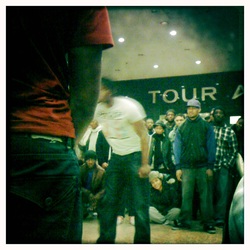
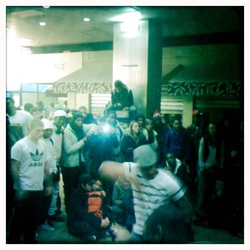
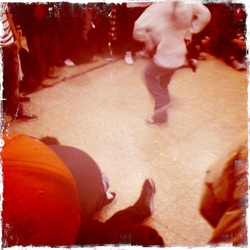
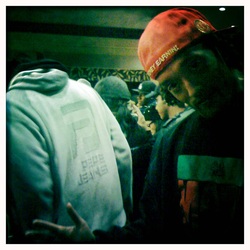





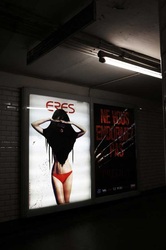
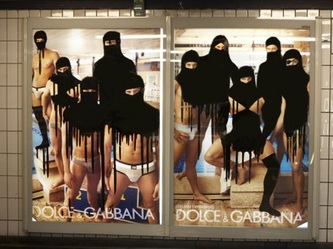
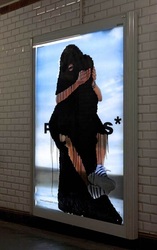
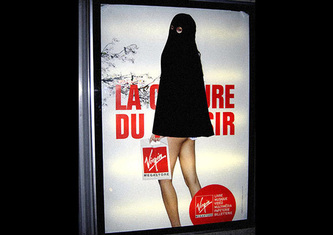










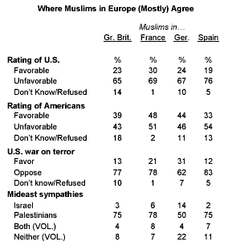
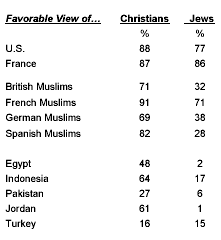


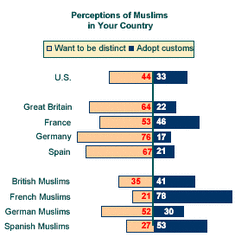
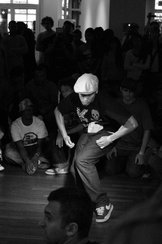
 RSS Feed
RSS Feed